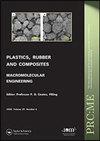Determination of carbon nanotubes penetration level into epoxy-woven glass fibre composite laminates manufactured with vacuum infusion process via electrical conductivity measurement
IF 1.2
4区 材料科学
Q3 MATERIALS SCIENCE, COMPOSITES
引用次数: 0
Abstract
ABSTRACT This study investigates the carbon nanotube (CNT) penetration phenomenon in vacuum infusion (VI) process by means of electrical conductivity measurement. Effects of resin temperature, CNT content, and the processing technique on the overall composite laminate quality were investigated by monitoring electrical properties of composite sheets. Epoxy/woven glass fibre composites loaded with various CNT contents were also manufactured using compression moulding and vacuum bagging techniques for comparison purposes. VI was achieved at two different temperatures (25°C and 50°C) to study the effect of variation in viscosity on CNT penetration during infusion. The results showed that electrical conductivity measurement was a very effective tool to assess the CNT penetration state of composite laminates in VI method. Both the resistive and capacitive behaviour in composite laminates due to filtration of CNTs at higher CNT contents was observed. However, the CNT penetration was improved by increasing the temperature of epoxy/CNT mixture before the infusion.电导率法测定真空灌注法制备的环氧玻璃纤维复合材料层板中碳纳米管的渗透水平
摘要采用电导率测量的方法研究了真空灌注过程中碳纳米管(CNT)的渗透现象。通过对复合材料电性能的监测,研究了树脂温度、碳纳米管含量和加工工艺对复合材料层合板整体质量的影响。为了进行比较,还使用压缩成型和真空装袋技术制造了装载各种碳纳米管内容的环氧树脂/编织玻璃纤维复合材料。在两种不同的温度(25°C和50°C)下实现VI,以研究粘度变化对碳纳米管在输注过程中的渗透的影响。结果表明,电导率测量是评价复合材料层合板碳纳米管渗透状态的有效工具。在高碳纳米管含量的情况下,观察到碳纳米管对复合材料层合板的阻性和容性行为。然而,在注入前提高环氧树脂/碳纳米管混合物的温度可以改善碳纳米管的渗透。
本文章由计算机程序翻译,如有差异,请以英文原文为准。
求助全文
约1分钟内获得全文
求助全文
来源期刊

Plastics, Rubber and Composites
工程技术-材料科学:复合
CiteScore
4.10
自引率
0.00%
发文量
24
审稿时长
4 months
期刊介绍:
Plastics, Rubber and Composites: Macromolecular Engineering provides an international forum for the publication of original, peer-reviewed research on the macromolecular engineering of polymeric and related materials and polymer matrix composites. Modern polymer processing is increasingly focused on macromolecular engineering: the manipulation of structure at the molecular scale to control properties and fitness for purpose of the final component. Intimately linked to this are the objectives of predicting properties in the context of an optimised design and of establishing robust processing routes and process control systems allowing the desired properties to be achieved reliably.
 求助内容:
求助内容: 应助结果提醒方式:
应助结果提醒方式:


